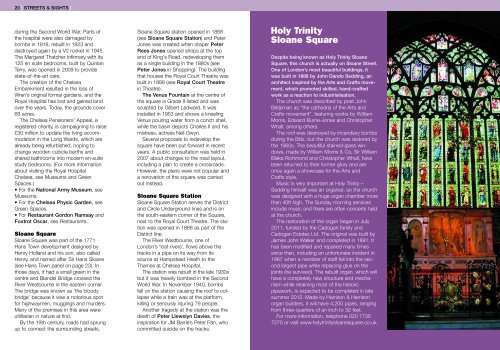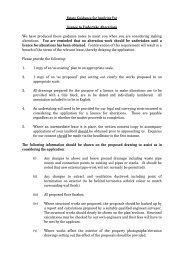The best of Chelsea by the people who know - Cadogan
The best of Chelsea by the people who know - Cadogan
The best of Chelsea by the people who know - Cadogan
Create successful ePaper yourself
Turn your PDF publications into a flip-book with our unique Google optimized e-Paper software.
20 | STREETS & SIGHTS |<br />
during <strong>the</strong> Second World War. Parts <strong>of</strong><br />
<strong>the</strong> hospital were also damaged <strong>by</strong><br />
bombs in 1918, rebuilt in 1923 and<br />
destroyed again <strong>by</strong> a V2 rocket in 1945.<br />
<strong>The</strong> Margaret Thatcher Infirmary with its<br />
125 en suite bedrooms, built <strong>by</strong> Quinlan<br />
Terry, was opened in 2009 to provide<br />
state-<strong>of</strong>-<strong>the</strong>-art care.<br />
<strong>The</strong> creation <strong>of</strong> <strong>the</strong> <strong>Chelsea</strong><br />
Embankment resulted in <strong>the</strong> loss <strong>of</strong><br />
Wren’s original formal gardens, and <strong>the</strong><br />
Royal Hospital has lost and gained land<br />
over <strong>the</strong> years. Today, <strong>the</strong> grounds cover<br />
66 acres.<br />
<strong>The</strong> <strong>Chelsea</strong> Pensioners’ Appeal, a<br />
registered charity, is campaigning to raise<br />
£30 million to update <strong>the</strong> living accommodation<br />
in <strong>the</strong> Long Wards, which are<br />
already being refurbished, hoping to<br />
change wooden cubicle berths and<br />
shared bathrooms into modern en-suite<br />
study bedrooms. (For more information<br />
about visiting <strong>the</strong> Royal Hospital<br />
<strong>Chelsea</strong>, see Museums and Green<br />
Spaces.)<br />
• For <strong>the</strong> National Army Museum, see<br />
Museums.<br />
• For <strong>the</strong> <strong>Chelsea</strong> Physic Garden, see<br />
Green Spaces.<br />
• For Restaurant Gordon Ramsay and<br />
Foxtrot Oscar, see Restaurants.<br />
Sloane Square<br />
Sloane Square was part <strong>of</strong> <strong>the</strong> 1771<br />
Hans Town development designed <strong>by</strong><br />
Henry Holland and his son, also called<br />
Henry, and named after Sir Hans Sloane<br />
(see Hans Town panel on page 23). In<br />
those days, it had a small green in <strong>the</strong><br />
centre and Blandel Bridge crossed <strong>the</strong><br />
River Westbourne in <strong>the</strong> eastern corner.<br />
<strong>The</strong> bridge was <strong>know</strong>n as '<strong>the</strong> bloody<br />
bridge’ because it was a notorious spot<br />
for highwaymen, muggings and murders.<br />
Many <strong>of</strong> <strong>the</strong> premises in this area were<br />
utilitarian in nature at first.<br />
By <strong>the</strong> 19th century, roads had sprung<br />
up to connect <strong>the</strong> surrounding streets.<br />
Sloane Square station opened in 1868<br />
(see Sloane Square Station) and Peter<br />
Jones was created when draper Peter<br />
Rees Jones opened shops at <strong>the</strong> top<br />
end <strong>of</strong> King's Road, redeveloping <strong>the</strong>m<br />
as a single building in <strong>the</strong> 1880s (see<br />
Peter Jones in Shopping). <strong>The</strong> building<br />
that houses <strong>the</strong> Royal Court <strong>The</strong>atre was<br />
built in 1888 (see Royal Court <strong>The</strong>atre<br />
in <strong>The</strong>atre).<br />
<strong>The</strong> Venus Fountain at <strong>the</strong> centre <strong>of</strong><br />
<strong>the</strong> square is Grade II-listed and was<br />
sculpted <strong>by</strong> Gilbert Ledward. It was<br />
installed in 1953 and shows a kneeling<br />
Venus pouring water from a conch shell,<br />
while <strong>the</strong> basin depicts Charles II and his<br />
mistress, actress Nell Gwyn.<br />
Several proposals to redevelop <strong>the</strong><br />
square have been put forward in recent<br />
years. A public consultation was held in<br />
2007 about changes to <strong>the</strong> road layout,<br />
including a plan to create a crossroads.<br />
However, <strong>the</strong> plans were not popular and<br />
a renovation <strong>of</strong> <strong>the</strong> square was carried<br />
out instead.<br />
Sloane Square Station<br />
Sloane Square Station serves <strong>the</strong> District<br />
and Circle Underground lines and is on<br />
<strong>the</strong> south-eastern corner <strong>of</strong> <strong>the</strong> Square,<br />
next to <strong>the</strong> Royal Court <strong>The</strong>atre. <strong>The</strong> station<br />
was opened in 1868 as part <strong>of</strong> <strong>the</strong><br />
District line.<br />
<strong>The</strong> River Westbourne, one <strong>of</strong><br />
London’s ‘lost rivers’, flows above <strong>the</strong><br />
tracks in a pipe on its way from its<br />
source at Hampstead Heath to <strong>the</strong><br />
Thames at <strong>Chelsea</strong> Hospital.<br />
<strong>The</strong> station was rebuilt in <strong>the</strong> late 1930s<br />
but it was heavily bombed in <strong>the</strong> Second<br />
World War. In November 1940, bombs<br />
fell on <strong>the</strong> station causing <strong>the</strong> ro<strong>of</strong> to collapse<br />
while a train was at <strong>the</strong> platform,<br />
killing or seriously injuring 79 <strong>people</strong>.<br />
Ano<strong>the</strong>r tragedy at <strong>the</strong> station was <strong>the</strong><br />
death <strong>of</strong> Peter Llewelyn Davies, <strong>the</strong><br />
inspiration for JM Barrie’s Peter Pan, <strong>who</strong><br />
committed suicide on <strong>the</strong> tracks.<br />
Holy Trinity<br />
Sloane Square<br />
Despite being <strong>know</strong>n as Holy Trinity Sloane<br />
Square, this church is actually on Sloane Street.<br />
One <strong>of</strong> London’s most beautiful buildings, it<br />
was built in 1888 <strong>by</strong> John Dando Sedding, an<br />
architect inspired <strong>by</strong> <strong>the</strong> Arts and Crafts movement,<br />
which promoted skilled, hand-crafted<br />
work as a reaction to industrialisation.<br />
<strong>The</strong> church was described <strong>by</strong> poet John<br />
Betjeman as “<strong>the</strong> ca<strong>the</strong>dral <strong>of</strong> <strong>the</strong> Arts and<br />
Crafts movement”, featuring works <strong>by</strong> William<br />
Morris, Edward Burne-Jones and Christopher<br />
Whall, among o<strong>the</strong>rs.<br />
<strong>The</strong> ro<strong>of</strong> was destroyed <strong>by</strong> incendiary bombs<br />
during <strong>the</strong> Blitz, but <strong>the</strong> church was restored <strong>by</strong><br />
<strong>the</strong> 1960s. <strong>The</strong> beautiful stained-glass windows,<br />
made <strong>by</strong> William Morris & Co, Sir William<br />
Blake Richmond and Christopher Whall, have<br />
been returned to <strong>the</strong>ir former glory and are<br />
once again a showcase for <strong>the</strong> Arts and<br />
Crafts style.<br />
Music is very important at Holy Trinity –<br />
Sedding himself was an organist, so <strong>the</strong> church<br />
was designed with a huge organ chamber more<br />
than 40ft high. <strong>The</strong> Sunday morning services<br />
include music and <strong>the</strong>re are <strong>of</strong>ten concerts held<br />
at <strong>the</strong> church.<br />
<strong>The</strong> restoration <strong>of</strong> <strong>the</strong> organ began in July<br />
2011, funded <strong>by</strong> <strong>the</strong> <strong>Cadogan</strong> family and<br />
<strong>Cadogan</strong> Estates Ltd. <strong>The</strong> original was built <strong>by</strong><br />
James John Walker and completed in 1891. It<br />
has been modified and repaired many times<br />
since <strong>the</strong>n, including an unfortunate incident in<br />
1967 when a member <strong>of</strong> staff fell into <strong>the</strong> second<br />
largest pipe while replacing glue on <strong>the</strong><br />
joints (he survived). <strong>The</strong> rebuilt organ, which will<br />
have a completely new structure and mechanism<br />
while retaining most <strong>of</strong> <strong>the</strong> historic<br />
pipework, is expected to be completed in late<br />
summer 2012. Made <strong>by</strong> Harrison & Harrison<br />
organ builders, it will have 4,200 pipes, ranging<br />
from three-quarters <strong>of</strong> an inch to 32 feet.<br />
For more information, telephone 020 7730<br />
7270 or visit www.holytrinitysloanesquare.co.uk.







